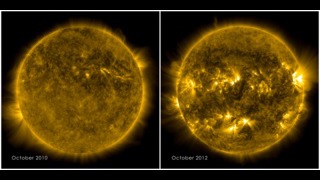Space Weather Forecast
The sun goes through a natural cycle approximately every 11 years, hitting peaks and valleys of solar activity. The cycle is marked by the increase and decrease of sunspots—visible as dark blemishes on the sun's surface and connected to eruptions such as solar flares and coronal mass ejections. The largest number of sunspots in any given solar cycle is designated as "solar maximum," and this next peak of activity is predicted to occur in 2013. The eruptions that occur during solar maximum can't harm humans on Earth. But scientists observe this activity, what they call space weather, because it can affect satellites in orbit and disrupt power grids on the ground. Watch the movie to see the kind of gigantic, and often beautiful, eruptions we expect to see more of in 2013.

Sunny with a chance of wild space weather.
These images from NASA's Solar Dynamics Observatory (SDO) show the range of eruptions and solar flares that we will see more of in 2013.

The sun was calm in fall 2010 (left), but had cycled toward solar maximum and a more active and varied solar atmosphere by fall 2012 (right).

Two wavelengths were blended in one image to create this SDO view of a large solar eruption in Aug. 2012.

As the sun moves toward solar maximum in 2013, more sunspots like these will appear on its surface.
For More Information
See NASA.gov
Credits
Please give credit for this item to:
NASA's Goddard Space Flight Center
-
Video editor
- Scott Wiessinger (USRA)
-
Producer
- Scott Wiessinger (USRA)
-
Writer
- Karen Fox (ADNET Systems, Inc.)
Release date
This page was originally published on Tuesday, January 1, 2013.
This page was last updated on Wednesday, May 3, 2023 at 1:52 PM EDT.
